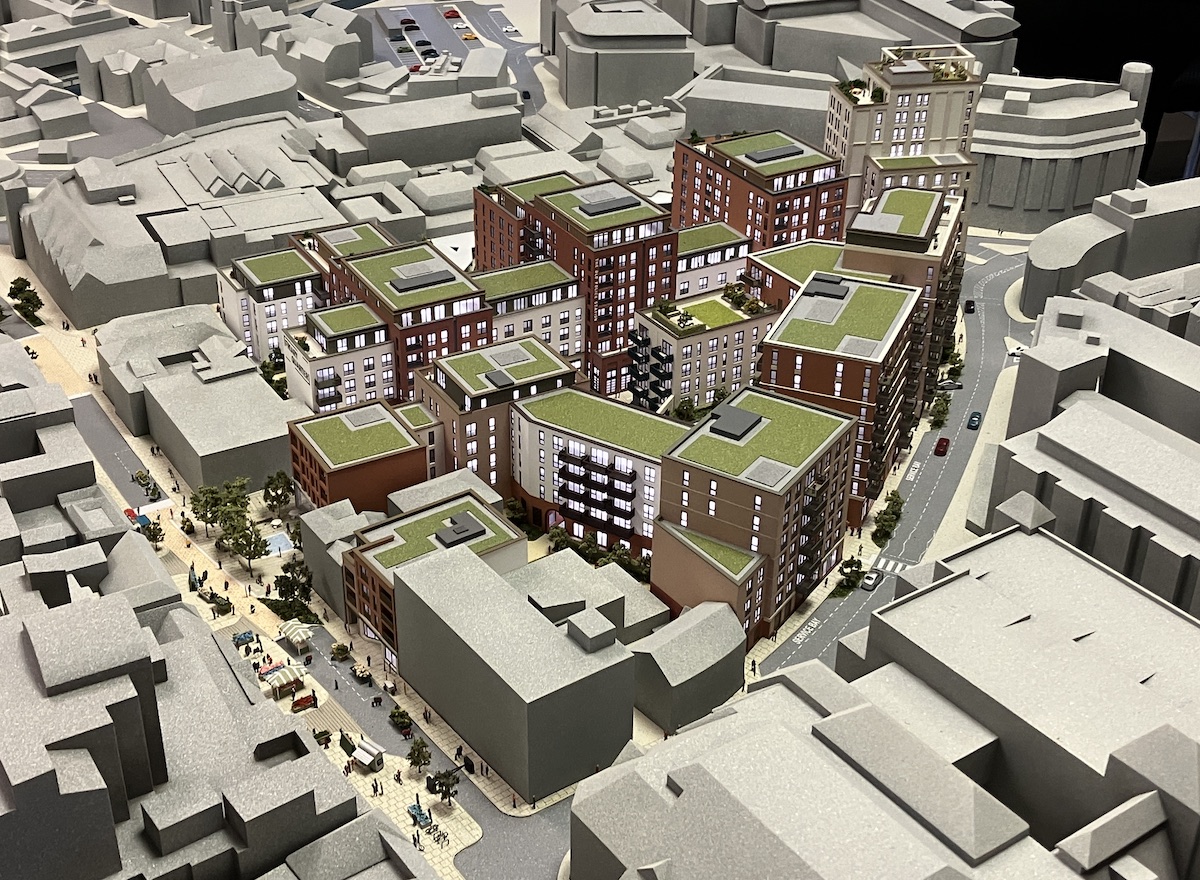 Abraham Lincoln
If given the truth, the people can be depended upon to meet any national crisis...
Abraham Lincoln
If given the truth, the people can be depended upon to meet any national crisis...
 Guildford news...
for Guildford people, brought to you by Guildford reporters - Guildford's own news service
Guildford news...
for Guildford people, brought to you by Guildford reporters - Guildford's own news service
Opinion: Why Let Guildford Be Ruined By ‘Monstrous Mass And Height’ Buildings?
Published on: 7 Nov, 2022
Updated on: 8 Nov, 2022
By Nic Allen RIBA
Most of us enjoy visiting towns and cities such as Oxford, Cambridge, Canterbury, Chichester and Winchester. Part of our enjoyment is that these towns and cities respect and enhance their heritage and have a reassuring and appealing consistency of scale of buildings.
Many of their streets are formed by buildings no more than four storeys in height. There are virtually no buildings in their centres higher with a few exceptions such as church steeples.
Their streets and public spaces have therefore a pleasing human scale with building heights to which we can relate.
 Streets with buildings of these heights permit good levels of daylight and, importantly, sunlight making the street a pleasant space to enjoy. Buildings of these heights also help permit views across their town or city centres and with some like Guildford’s longer vistas to the surrounding countryside, hills and landscape beyond.
Streets with buildings of these heights permit good levels of daylight and, importantly, sunlight making the street a pleasant space to enjoy. Buildings of these heights also help permit views across their town or city centres and with some like Guildford’s longer vistas to the surrounding countryside, hills and landscape beyond.
I would be shocked to see buildings of eight or ten storeys appearing in the centre of any of these towns or cities.

Screenshot from the Guildford Society website Changing Views Across Guildford.
Which raises the question, why is Guildford different? Why are there battles and division about all of the major projects in our town centre?
Is Guildford so much lesser of a town than these others that we don’t care how it is developed or we want to relegate it to a lower league?
See also: North Street Developer Cuts Tallest Building Height By One Storey
I believe all of these towns and cities have carefully written planning policies which are there to influence and protect the townscape of their centres.
Cambridge’s original tall buildings policy 2012 is now integrated into their Local Plan as Policy 60 which states:
“Any proposal for a structure that breaks the existing skyline and/or is significantly taller than the surrounding built form will be considered against the following criteria:
a. location, setting and context – applicants should demonstrate through visual assessment or appraisal with supporting accurate visual representations, how the proposals fit within the existing landscape and townscape;
b. impact on the historic environment – applicants should demonstrate and quantify the potential harm of proposals to the significance of heritage assets or other sensitive receptors (view of, backdrop and setting), assessed on a site-by-site basis but including impact on key landmarks and viewpoints, as well as from the main streets, bridges and open spaces in the city centre and from the main historic approaches, including road and river, to the historic core. Tall building proposals must ensure that the character or appearance of Cambridge, as a city of spires and towers emerging above the established tree line, remains dominant from relevant viewpoints as set out in Appendix F;
c. scale, massing and architectural quality – applicants should demonstrate through the use of scaled drawings, sections, accurate visual representations and models how the proposals will deliver a high-quality addition to the Cambridge skyline and clearly demonstrate that there is no adverse impact;
d. amenity and microclimate – applicants should demonstrate that there is no adverse impact on neighbouring buildings and open spaces in terms of the diversion of wind, overlooking or overshadowing, and that there is adequate sunlight and daylight within and around the proposals; and
e. public realm – applicants should show how the space around tall buildings will be detailed, including how a human scale is created at street level.”
These policies do not totally prevent taller buildings but are there to challenge why tall buildings are needed and if they can be justified make certain they are of absolutely the highest quality.
Canterbury’s Local Plan states:
“Building heights should be determined by the immediate context of a development. However, it is not expected that new buildings will exceed four residential storeys over an active ground floor (i.e. five storeys maximum height).”
Why does Guildford not have similar policies?
Our town is about to have its centre destroyed by buildings of excessive, some might say monstrous, mass and height. These, at eight storeys and above are totally out of scale with the generally three to four storey town centre. See the illustration of proposed Debenham’s replacement, St Mary’s Wharf, below.
It shows the view from the west. If you look hard you can see faintly the existing buildings behind. Through the gap between these huge new buildings is St Mary’s Church dwarfed by the new buildings. St Mary’s Saxon tower is the oldest structure in Guildford which sits in Quarry Street amongst some of Guildford’s most attractive, much-loved heritage buildings. All will be overshadowed and have their settings destroyed by new buildings of this mass and height.
The scale and impact of these huge developments is worsened when they are considered together as shown on the Guildford Society website: Changing View Across Guildford.
We will have no one else to blame for our town’s destruction if we don’t act now. Developers will continue to push through their excessive schemes knowing that the GBC policies are insufficient and even if applications are turned down by the council they can win on appeal as happened with Solum.
We all want to see new development in Guildford but not poorly conceived development that destroys our town.
Guildford’s attraction, as the other towns and cities I mention, is its heritage and townscape. Our town centre with its heritage and setting is an economic benefit.
Tall buildings and overdevelopment will just add to the often-quoted “Guildford has been spoilt” list of negatives at a time of economic downturn.
Why are the council, which should be safeguarding its future, avoiding the adoption of policies to protect it?
Responses to Opinion: Why Let Guildford Be Ruined By ‘Monstrous Mass And Height’ Buildings?
Leave a Comment Cancel reply
Please see our comments policy. All comments are moderated and may take time to appear. Full names, or at least initial and surname, must be given.Recent Articles
- A Splashing Time at Guildford Lions Club’s Raft Race 2025
- Stoke Park Paddling Pool Is Open Again Following Safety Investigation
- Ash Care Home Proposal For Vacant Bewley Site Moves To Next Stage
- ‘Long-anticipated’ Waverley Skate Park Planned for Cranleigh
- Men In Their 60s Arrested After Fight At Newlands Corner
- New Cancer Charity Offers Support To Patients On Road To Recovery
- Councillor Calls on Colleagues To Stop Patronising Parents of SEND Children
- ‘Catapults Must Be Treated Like Knives’ Says Deputy Police Commissioner
- New Study Shows Promise In The Diagnosis of Poor Blood Circulation
- Fake News To Be Examined at the Guildford Institute



Recent Comments
- Graham Vickery on Letter: Local Government Reorganisation Consultations Are Too Little, Too Late
- Peta Malthouse on Normandy Housing Plan Reignites Concerns Over ‘Damage To Our Community’
- Richard Cooke on Letter: Snail-paced Progress for Full Weir Repair
- Bethan Moore on Guildford’s First “Bike Bus”
- Andy Friend-Smith on Guildford’s First “Bike Bus”
- Peter Mills on Guildford’s First “Bike Bus”
Search in Site
Media Gallery
Dragon Interview: Local Artist Leaves Her Mark At One of England’s Most Historic Buildings
January 21, 2023 / No Comment / Read MoreDragon Interview: Lib Dem Planning Chair: ‘Current Policy Doesn’t Work for Local People’
January 19, 2023 / No Comment / Read MoreA3 Tunnel in Guildford ‘Necessary’ for New Homes, Says Guildford’s MP
January 10, 2023 / No Comment / Read More‘Madness’ for London Road Scheme to Go Ahead Against ‘Huge Opposition’, Says SCC Leader
January 6, 2023 / No Comment / Read MoreCouncillor’s Son Starts Campaign for More Consultation on North Street Plan
December 30, 2022 / No Comment / Read MoreCounty Council Climbs Down Over London Road Works – Further ‘Engagement’ Period Announced
December 14, 2022 / No Comment / Read MoreDragon Interview: GBC Reaction to the Government’s Expected Decision to Relax Housing Targets
December 7, 2022 / No Comment / Read MoreHow Can Our Town Centre Businesses Recover? Watch the Shop Front Debate
May 18, 2020 / No Comment / Read More














Ben Paton
November 7, 2022 at 10:56 am
Congratulations on a reasoned and evidenced argument.
The borough council should respond.
Will it?
Jim Allen
November 7, 2022 at 1:18 pm
I seem to remember these tall buildings in London causing plastic on buildings opposite to melt as sunlight was concentrated and focussed. Hasanyone checked the “sunlight effect” of these tall buildings on their surroundings?
J Corfield
November 8, 2022 at 9:01 am
“Pleasing human scale” so underestimated today. Hope Guildford will take note of Nic Allen’s wise observations. Thankfully, to date, Edinburgh can be added to your examples.
David Ogilvie
November 8, 2022 at 12:56 pm
Nic Allen is right, Guildford should be implementing a town centre policy of a maximum of 18 meters overall height. Developers would then value sites accordingly and still be able to develop profitably.
As it is, 10-storey height has been established by the Solum station approval and this has set the bar at a height to be beaten by the next development. The North Street development application and the proposed GBC’s proposal for Guildford Park Road both have gone to 13 stories setting a new precedent.
When will this stop? Will it continue until the Guildford Valley if filled with tall buildings.
John Baxter
November 8, 2022 at 6:16 pm
Guildford is already ruined. Vast derelict areas in the town centre have existed for decades because no-one ever makes a decision. We need lots of housing on brownfield land which will benefit the town and the businesses in the town.
The proposed heights and densities are hardly excessive in this day and age. Once again I fear no decision will ever be made and all the derelict land, now expanded with the Debenhams site, will continue to blight the town forever.